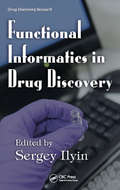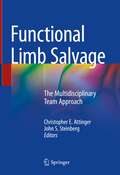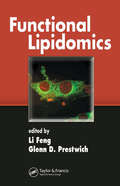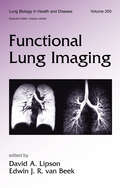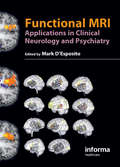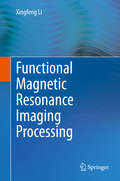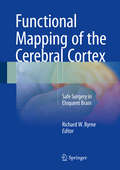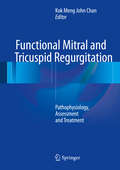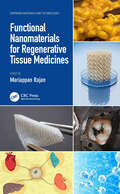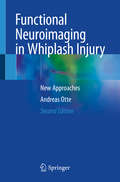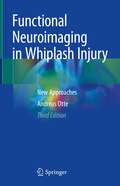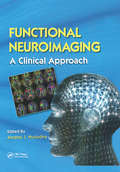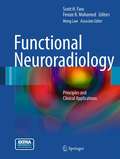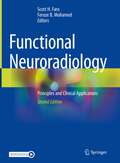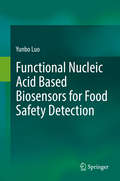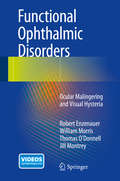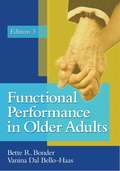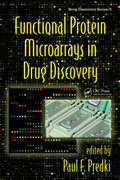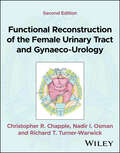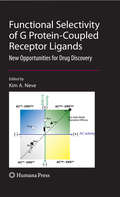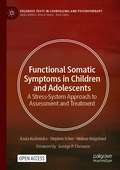- Table View
- List View
Functional Informatics in Drug Discovery (Drug Discovery Ser. #Vol. 9)
by Sergey IlyinIntegrating various technologies with informational systems provides vast improvements to the overall research and development that occur in the biopharmaceutical industry. One of the first books to explore this area, Functional Informatics in Drug Discovery examines all aspects of technology integration and information flow in a biopharmaceutical
Functional Limb Salvage: The Multidisciplinary Team Approach
by Christopher E. Attinger John S. SteinbergTaking a truly interdisciplinary approach to the topic, Functional Limb Salvage is a ready reference for all clinicians and surgeons treating this patient population, including plastic, vascular, orthopedic and podiatric surgeons and their support staff. The content of this text is focused on defining and expanding upon the importance and, more specifically, the intricacies of the multidisciplinary team approach. Although this is often touched upon or cited as an integral aspect of care, there are only sparse descriptions of the interplay of multiple team members in concert with the care of this challenging patient population. This comprehensive text opens with definitions, demographics, epidemiology, pathophysiology and etiology of the limb salvage patient population, whether due to infection, ischemia or deformity. The multidisciplinary team itself is then outlined, from the who, when and where of the intervention to the role of the individual clinicians themselves; from vascular and plastic surgeons to podiatric and orthopedic surgeons, multiple medical specialties, and with thorough attention to the integral support staff of NPs, PAs and many others. History and assessment are then discussed as a prelude to both conservative and surgical treatments, including wound healing optimization, orthotics and prosthetics, skin grafting, amputation, bioengineered tissue and more. A final chapter on innovation and landmark publications rounds out the presentation.
Functional Lipidomics
by Li Feng Glenn D. PrestwichLipids play an essential role in cell signaling and subcellular structure. Systematic analysis of the total lipid structure of a cell or organism, the lipodome, can reveal novel avenues of therapeutic intervention and diagnosis. This analysis is best modeled after the lessons learned from proteomics. With contributions from pioneering researchers f
Functional Lung Imaging
by David A. Lipson Edwin J. R. van BeekWritten by world authorities, this reference explores the utilization and advancement of state-of-the-art imaging modalities for the analysis of pulmonary function-providing an up-to-date and global perspective of imaging applications with detailed contributions from experts in Europe, North America, Japan, and Australia.
Functional MRI: Applications in Clinical Neurology and Psychiatry
by Mark D’EspositoFunctional imaging has the capability to reveal changes in the pathophysiology of tissues and organ systems, mapping the progression and severity of disease, uptake of drugs, and the recovery of tissues following trauma, disease episodes or surgery. In this authoritative new work, leading specialists in neurology and neuroimaging present an update
Functional Magnetic Resonance Imaging Processing
by Xingfeng LiWith strong numerical and computational focus, this book serves as an essential resource on the methods for functional neuroimaging analysis, diffusion weighted image analysis, and longitudinal VBM analysis. It includes four MRI image modalities analysis methods. The first covers the PWI methods, which is the basis for understanding cerebral flow in human brain. The second part, the book's core, covers fMRI methods in three specific domains: first level analysis, second level analysis, and effective connectivity study. The third part covers the analysis of Diffusion weighted image, i. e. DTI, QBI and DSI image analysis. Finally, the book covers (longitudinal) VBM methods and its application to Alzheimer's disease study.
Functional Mapping of the Cerebral Cortex
by Richard W. ByrneThis book provides up-to-date, practical information on functional mapping in order to assist neurosurgeons responsible for safely removing lesions in and around eloquent cortex - one of the greatest challenges in neurosurgery. The roles of pre- and intraoperative mapping techniques are clearly explained, highlighting the advantages and limitations of each tool available to the neurosurgeon. The inclusion of treatment algorithms for applications in specific clinical circumstances ensures that the book will serve as a clear guide to this most complex of neurosurgical problems. To further assist the reader, instructive clinical case examples, accompanied by intraoperative photos and other illustrative material, help to explain the applications of functional mapping of eloquent cortex in different pathologies. Practitioners will find the book to be a ready guide to navigation of the practical decisions commonly faced when operating in eloquent cortex.
Functional Mitral and Tricuspid Regurgitation
by Kok Meng John ChanThis book covers in detail all aspects of functional mitral and tricuspid regurgitation, from its pathophysiology and natural history, to its assessment, medical and surgical treatment, and long term results. Functional Mitral and Tricuspid Regurgitation encompasses information and knowledge from a diverse background including cardiology, cardiac surgery and basic science. This is necessary for a full understanding of the subject in order to optimally manage patients with this condition.
Functional Movement Disorder: An Interdisciplinary Case-Based Approach (Current Clinical Neurology)
by Kathrin LaFaver Carine W. Maurer Timothy R. Nicholson David L. PerezThis book is a practical manual for clinical practitioners seeking to take an interdisciplinary and multidisciplinary approach to the diagnosis and management of functional movement disorder (FMD). It discusses case vignettes, reviews the diagnostic approach, provides an update on available treatments, highlights clinical pearls and details references for further reading.Organized into three parts, the book begins with a framework for conceptualizing FMD - including its historical context, the biopsychosocial model and an integrated neurologic-psychiatric perspective towards overcoming mind-body dualism. Part II then provides a comprehensive overview of different FMD presentations including tremor, dystonia, gait disorders, and limb weakness, as well as common non-motor issues such as pain and cognitive symptoms. The book concludes with chapters on updated practices in delivering the diagnosis, working with patients and care partners to achieve shared understanding of a complex condition, as well as an overview of evidence-based and evolving treatments. Supplemented with high-quality patient videos, Functional Movement Disorder is written for practicing neurologists, psychiatrists, psychologists, allied mental health professionals, and rehabilitation experts with an interest in learning more about diagnosis and management of FMD.
Functional Nanomaterials for Regenerative Tissue Medicines (Emerging Materials and Technologies)
by Mariappan RajanThis book covers nanomaterials in tissue engineering for regenerative therapies of heart, skin, eye, skeletal muscle, and the nervous system. The book emphasizes fundamental design concepts and emerging forms of nanomaterials in soft- and hard-tissue engineering. FEATURES Fills a gap in the literature related to the application of nanomaterials in hard- and soft-tissue regeneration, repair, and restructure Discusses a variety of applications, including cardiac, kidney, liver, bone, wound healing, artificial organs, and dental Presents advantages and limitations of various nanomaterials alongside future challenges Functional Nanomaterials for Regenerative Tissue Medicines is essential for academics and industry professionals working in tissue engineering, biomedicine, biopharmaceuticals, and nanotechnology. It is primarily intended for materials researchers (to develop the platforms related to tissue regeneration) as well as clinicians (to learn and apply nanomaterials in their practice) and industrial scientists (to develop commercial blood substitute products).
Functional Neuroimaging in Exercise and Sport Sciences
by Charles H. Hillman Henning Boecker Lukas Scheef Heiko K. StrüderRegular physical exercise is associated with substantial health benefits. Recent evidence not only holds for cardiovascular effects promoting "physical health", but also for the central nervous system believed to promote "brain health". Moderate physical exercise has been found to improve learning, memory, and attentional processing, with recent research indicating that neuroprotective mechanisms and associated plasticity in brain structure and function also benefit. Physical exercise is also known to induce a range of acute or sustained psychophysiological effects, among these mood elevation, stress reduction, anxiolysis, and hypoalgesia. Today, modern functional neuroimaging techniques afford direct measurement of the acute and chronic relation of physical exercise on the human brain, as well as the correlation of the derived physiological in vivo signals with behavioral outcomes recorded during and after exercise. A wide range of imaging techniques have been applied to human exercise research, ranging from electroencephalography (EEG), magnetoencephalography (MEG), near infrared spectroscopy (NIRS), magnetic resonance imaging (MRI) to positron emission tomography (PET). All of these imaging methods provide distinct information, and they differ considerably in terms of spatial and temporal resolution, availability, cost, and associated risks. However, from a "multimodal imaging" perspective, neuroimaging provides an unprecedented potential to unravel the neurobiology of human exercise, covering a wide spectrum ranging from structural plasticity in gray and white matter, network dynamics, global and regional perfusion, evoked neuronal responses to the quantification of neurotransmitter release. The aim of this book is to provide the current state of the human neuroimaging literature in the emerging field of the neurobiological exercise sciences and to outline future applications and directions of research.
Functional Neuroimaging in Whiplash Injury: New Approaches
by Andreas OtteThis book, now in its second, completely revised and updated edition, offers a critical approach to the challenging interpretation of the latest research data obtained using functional neuroimaging in whiplash injury. Such a comprehensive guide to recent and current international research in the field is more necessary than ever, given that the confusion regarding the condition and the medicolegal discussions surrounding it have increased further despite the publication of much literature on the subject. In recent decades especially the functional imaging methods – such as single-photon emission tomography, positron emission tomography, functional MRI, and hybrid techniques – have demonstrated a variety of significant brain alterations. Functional Neuroimaging in Whiplash Injury - New Approaches covers all aspects, including the imaging tools themselves, the various methods of image analysis, different atlas systems, and diagnostic and clinical aspects. The book will help physicians, patients and their relatives and friends, and others to understand this condition as a disease.
Functional Neuroimaging in Whiplash Injury: New Approaches
by Andreas OtteThis book, now in its third, completely revised and updated edition, offers a critical approach to the challenging interpretation of the latest research data obtained using functional neuroimaging in whiplash injury. Such a comprehensive guide to recent and current international research in the field is more necessary than ever, given that the confusion regarding the condition and the medicolegal discussions surrounding it have increased further despite the publication of much literature on the subject. In recent decades especially the functional imaging methods – such as single-photon emission tomography, positron emission tomography, functional MRI, and hybrid techniques – have demonstrated a variety of significant brain alterations. Functional Neuroimaging in Whiplash Injury - New Approaches covers all aspects, including the imaging tools themselves and the various methods of image analysis. Details on biomechanics, including the finite element method and facts on historical whiplash experiments and crash tests have now been added to this new edition. The book will continue to help physicians, patients and their relatives and friends, and others to understand this condition as a disease.
Functional Neuroimaging: A Clinical Approach
by Andrei HolodnyThe first text designed specifically with clinical practitioners in mind, Functional Neuroimaging demonstrates the clinical application and utilization of functional neuroradiology for early diagnosis, neurological decision-making, and assessing response to cancer therapy. Edited by the Founding President of American Society of Functional Neuroradi
Functional Neuroradiology
by Feroze B. Mohamed Scott H. Faro John T. Ulmer Meng LawFunctional Neuroradiology: Principles and Clinical Applications, is a follow-up to Faro and Mohamed's groundbreaking work, Functional (BOLD)MRI: Basic Principles and Clinical Applications. This new 49 chapter textbook is comprehensive and offers a complete introduction to the state-of-the-art functional imaging in Neuroradiology, including the physical principles and clinical applications of Diffusion, Perfusion, Permeability, MR spectroscopy, Positron Emission Tomography, BOLD fMRI and Diffusion Tensor Imaging. With chapters written by internationally distinguished neuroradiologists, neurologists, psychiatrists, cognitive neuroscientists, and physicists, Functional Neuroradiology is divided into 9 major sections, including: Physical principles of all key functional techniques, Lesion characterization using Diffusion, Perfusion, Permeability, MR spectroscopy, and Positron Emission Tomography, an overview of BOLD fMRI physical principles and key concepts, including scanning methodologies, experimental research design, data analysis, and functional connectivity, Eloquent Cortex and White matter localization using BOLD fMRI and Diffusion Tensor Imaging, Clinical applications of BOLD fMRI in Neurosurgery, Neurology, Psychiatry, Neuropsychology, and Neuropharmacology, Multi-modality functional Neuroradiology, Beyond Proton Imaging, Functional spine and CSF imaging, a full-color Neuroanatomical Brain atlas of eloquent cortex and key white matter tracts and BOLD fMRI paradigms. By offering readers a complete overview of functional imaging modalities and techniques currently used in patient diagnosis and management, as well as emerging technology, Functional Neuroradiology is a vital information source for physicians and cognitive neuroscientists involved in daily practice and research.
Functional Neuroradiology: Principles and Clinical Applications
by Feroze B. Mohamed Scott H. FaroThis new edition fully updates and expands Faro and Mohamed’s Functional Neuroradiology, a gold standard, comprehensive introduction to the state-of-the-art functional imaging in neuroradiology, including the physical principles and clinical applications of Diffusion, Perfusion, Permeability, MR spectroscopy, Positron Emission Tomography, BOLD fMRI and Diffusion Tensor Imaging. With chapters written by internationally distinguished neuroradiologists, neurologists, psychiatrists, cognitive neuroscientists, and physicists, Functional Neuroradiology is divided into 12 major sections, including: Diffusion and Perfusion Imaging, Magnetic Resonance Spectroscopy and Chemical Exchange Saturation Transfer Imaging, Multi-Modality Functional Neuroradiology, BOLD Functional MRI, Diffusion Tensor Imaging, Presurgical Brain Tumor Mapping, Emerging neuroimaging techniques, Functional Spine and Hydrocephalus imaging, and Neuroanatomical Gray and White matter Brain Atlases. This second edition is fully updated throughout and includes more than 15 new chapters on topics such as: Brain tumor Radiogenomics, CNS Tumor Surveillance and Functional MR Perfusion Imaging, CNS Machine Learning, Focused Ultrasound therapy, TBI Sports Related Injury, and CNS Lymphatic system. By offering readers a complete overview of functional imaging modalities and techniques currently used in patient diagnosis and management, as well as emerging technology, Functional Neuroradiology is a vital information source for physicians and cognitive neuroscientists involved in daily practice and research.
Functional Nucleic Acid Based Biosensors for Food Safety Detection
by Yunbo LuoThis book highlights the development of a functional nucleic acid based biosensor detection method in the context of food safety. Although there have been major advances in food processing technology in both developed and developing countries, food safety assurance systems are generally becoming more stringent, in response to growing (both real and perceived) food safety problems. These problems are due in part to foodborne microorganisms, heavy metals, and small chemical molecules (biological toxins, pesticide residues, and veterinary drug residues), etc. In addition, the nucleic acid biomarkers (DNA methylation, microRNA, and circRNA) induced by these risk factors are also closely related to food safety. Accordingly, this book offers a brief guide to targets and strategies in functional nucleic acid based biosensors for food safety detection. Divided into several chapters that focus on various respective targets, it will be a valuable resource for students and researchers in the fields of biosensor detection, food science etc.
Functional Ophthalmic Disorders
by William Morris Thomas O'Donnell Robert Enzenauer Jill MontreyThis is a practical manual for diagnostic testing, focusing on the historical and contemporary research on functional disorders in general, and functional visual disorders in particular. Functional Ophthalmic Disorders: Ocular Malingering and Visual Hysteria is a how-to manual that is written for the practicing ophthalmologist and optometrist, complete with color photos that allow the reader to see pictures of select diseases. In addition to the photos, videos are provided online to illustrate the various tests and possible results conducted on a mock patient to assist in the differential diagnosis. Written and edited by leaders in the field, some of the topics covered include history of functional disorders, ophthalmologic examination in malingering and techniques and tests for functional and simulated defects.
Functional Performance in Older Adults (Third Edition)
by Bette R. Bonder Vanina Dal Bello-Haas Marilyn B. Wagner Bette Bonder Vanina Bello-Haas"The contributors represent diverse disciplines, however their messages create a coherent, integrated work of universal interest and application. I highly recommend the use of this text for allied health students who are studying geriatric rehabilitation and for clinicians who wish to renew their knowledge. "--Carole Knight, MEd, OTR/L, Occupational Therapy in Health Care Journal, Volume 16, Number 2/3 February 2003, review of the 2nd Edition. The ideal resource for rehabilitation professionals who are working with or preparing to work with older adults! It describes the normal aging process, illustrates how health and social factors can impede an aging person's abilities, and demonstrates how to develop mechanisms for maximizing the well-being of older adults.
Functional Protein Microarrays in Drug Discovery (Drug Discovery Series)
by Paul F. PredkiAn ideal text for biotechnologists, protein chemists, and biochemists, Functional Protein Microarrays in Drug Discovery explores all aspects of functional protein microarrays, including basic principles, methods, and applications. The book discusses the generation of functional protein content and describes both standard and state-of-the-art fabrication methods. It reviews current and next generation approaches to assay detection and presents a wide range of applications, from biomolecular interaction discovery and characterization to immune response profiling. The book also addresses several fundamental computational issues, bioinformatics and data analysis.
Functional Reconstruction of the Female Urinary Tract and Gynaeco-Urology
by Christopher R. Chapple Nadir I. Osman Richard T. Turner-WarwickOverview of female urological reconstructive surgery with illustrations, photographs, and diagrams spanning all surgical procedures in the field Functional Reconstruction of the Female Urinary Tract and Gynaeco-Urology is a comprehensive reference text encompassing the entire field of reconstructive female urology, delivering in-depth knowledge of structure, function, and dysfunction of the female urinary tract and imparting a thorough understanding of the principles of urodynamics related to lower urinary tract reconstruction. In this Second Edition, authors Christopher Chapple and Nadir Osman have retained many of the original descriptions from the first edition in tribute to the work of Richard Turner-Warwick, who is considered the father of functional urological reconstruction in the United Kingdom. Where appropriate, the text and comments have been updated to reflect developments in the field. In Functional Reconstruction of the Female Urinary Tract and Gynaeco-Urology, readers will find: Detailed descriptions of surgical principles and procedures with 1600 colour illustrations based on original drawings by Paul Richardson.“Tricks of the trade”, “pearls of wisdom”, and other original concepts related to the field.The principles, art, and philosophy of surgery, as well as details on instruments and surgical access to the urinary tract.Information on surgical management of conditions that a specialist surgeon working in this field will encounter in their clinical practice. Functional Reconstruction of the Female Urinary Tract and Gynaeco-Urology is an essential one-of-a-kind reference for surgeons at any level of practice, regardless of training or experience. The text is also valuable for advanced students in related programmes of study.
Functional Respiratory Disorders
by Ran D AnbarMany patients with pulmonary complaints fail to improve despite physicians' best efforts. Sometimes, we ascribe this failure to lack of adherence with therapy, or to the severity of the condition. What we often fail to appreciate, however, is that sometimes the lack of improvement can be explained by the patients' psychological states. The first section of Functional Respiratory Disorders: When Respiratory Symptoms Do Not Respond to Pulmonary Treatment will help clinicians recognize functional respiratory symptoms that can arise as a result of both organic and psychological causes. The second section of this book provides detailed discussions of such disorders, links to video examples of laryngoscopic evaluation of patients with vocal cord issues, case studies and quizzes. Examples and exercises that should strengthen the clinician's confidence in identifying and treating these functional conditions are also provided. Finally, the third section of the book will help the clinician differentiate the patients for whom referral to a mental health provider is mandatory from those for whom other approaches may be useful. For the latter group, the book teaches clinicians to empower themselves by learning how to incorporate various therapies for functional disorders into their practice, including biofeedback, breathing techniques, basic cognitive behavioral therapy techniques, and hypnosis. Links are provided to instructive video examples of biofeedback, hypnosis, and speech therapy. Practical strategies for obtaining training in these modalities are provided in the appendix. Functional Respiratory Disorders: When Respiratory Symptoms Do Not Respond to Pulmonary Treatment is an important new book that will help clinicians consider the possible impact of functional contributions to the clinical presentation of every patient with respiratory symptoms and identified respiratory disease.
Functional Selectivity of G Protein-Coupled Receptor Ligands
by Kim NeveFunctional selectivity refers to the ability of different ligands acting at one receptor subtype to activate multiple signaling pathways in unique combinations; that is, one drug can be an agonist at pathway A and an antagonist or partial agonist at pathway B, and another drug can have the reverse profile. Functional selectivity has profound implications for drug development, for chemical biology, and for the design of experiments to characterize receptor function. In Functional Selectivity of G Protein-Coupled Receptors expert neuroscientists and pharmacologists review the work that demonstrated the existence of functional selectivity, placed it within a theoretical framework, and provided a mechanistic basis for the phenomenon. This exciting, comprehensive, and future-oriented volume includes chapters that focus on theoretical and mechanistic aspects of functional selectivity and that cut across subfamilies of GPCRs. Additional chapters focus on subfamilies of therapeutically relevant receptors where there is considerable evidence of ligand functional selectivity. Accessible and authoritative, Functional Selectivity of G Protein-Coupled Receptors is a valuable educational tool and reference source for students and scientists interested in drug development, chemical biology, and GPCR function.
Functional Smart Nanomaterials and Their Theranostics Approaches (Smart Nanomaterials Technology)
by Rajendra Prasad Azamal Husen Alle Madhusudhan Shiv Dutt PurohitThis book covers a number of engineered nanotheranostics platforms and nanomedicines applications of FDA-approved medicines for early-stage diagnosis and treatment of cancer. The book focuses on (i) the basic design and bioengineering of safe medicines, (ii) physicochemical understanding of surface engineered medicines and their characteristics, (iii) various examples for site-specific bioimaging and multimode therapies, (iv) stimuli-responsive approaches for targeted drug delivery applications, (v) targeted therapeutics approaches for cancer cells or solid tumor ablations, (vi) targeted mechanisms of administrative biomedicines, (vii) impact of surface modification or engineering of biomedicines for site-selective tumor binding ability, and (vii) requirements for clinical trials and FDA approval. The content of this book appeal to readers who are interested in recent developments of FDA-approved cost-effective rapid cancer imaging and therapeutic platforms.
Functional Somatic Symptoms in Children and Adolescents: A Stress-System Approach to Assessment and Treatment (Palgrave Texts in Counselling and Psychotherapy)
by Stephen Scher Kasia Kozlowska Helene HelgelandThis open access book sets out the stress-system model for functional somatic symptoms in children and adolescents. The book begins by exploring the initial encounter between the paediatrician, child, and family, moves through the assessment process, including the formulation and the treatment contract, and then describes the various forms of treatment that are designed to settle the child’s dysregulated stress system. This approach both provides a new understanding of how such symptoms emerge – typically, through a history of recurrent or chronic stress, either physical or psychological – and points the way to effective assessment, management, and treatment that put the child (and family) back on the road to health and well-being.
